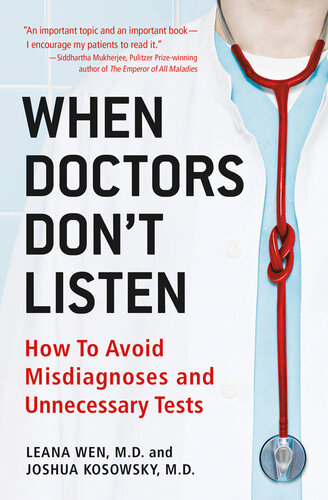
When Doctors Don't Listen
How to Avoid Misdiagnoses and Unnecessary Tests
چگونه از تشخیص نادرست و آزمونهای غیرضروری اجتناب کنیم
کتاب های مرتبط
- اطلاعات
- نقد و بررسی
- دیدگاه کاربران
نقد و بررسی

October 15, 2012
Doctors Wen and Kosowsky (Pocket Emergency Medicine, co-editor) nudge the medical “consumer empowerment movement” forward with this provocative dialogic guide to help patients get the right diagnosis and treatment while avoiding the pitfalls of formulaic “cookbook” medicine. It all starts with an open conversation, the pair assert—much like the banter between car owner and mechanic on NPR’s popular Car Talk program—and ends with an active M.D.-patient partnership. “You are the key to your own health, and you have to help your doctor help you,” the duo insist. Recounted are hair-raising stories of patients who bore the brunt of doctors leaping to “worst-case reasoning” instead of listening to what their patients were telling them, like Jerry the car mechanic with a pulled muscle who was treated for a heart attack. The team warns consumers that the transformation from passive recipient of medical care to active partner won’t be easy, but provide plenty of how-tos in their “8 Pillars” toward building a patient-doctor partnership. Theirs is an urgent call to action for patients, and a stark heads-up for doctors and the troubled healthcare industry they serve. 4 graphs. Agent: Jessica Papin, Dystel & Goderich Literary Management.

November 1, 2012
A comprehensive guide to improving doctor-patient relations through empowering patients to take an active role in their care. Managed care has put pressure on doctors to do the most work in the smallest amount of time possible, and even the best-intentioned of physicians can fall prey to corner cutting and misdiagnoses. Doctors Wen and Kosowsky suggest change can come from the ground up by making sure patients and clients are more directive in managing how their interactions progress. "We aim for this to be the opening salvo of a revolution among patients to improve the quality of their own care and to lead the way to true healthcare reform," they write. Toward this end, the authors provide a raft of anecdotal stories that double as scenarios many patients encounter: being rushed, doctors downplaying concerns, having close-ended "cookbook medicine" questions determine the course of the interaction, and other situations leading to reductive diagnoses. All of the experiences shared lead into actionable steps patients can take toward being "better patients" as well as working to pressure doctors into providing better care--steering the conversation away from close-ended questions, insisting on both explanations for recommended tests and exploring alternatives, and making yourself an active partner in reaching a differential diagnosis. In the appendixes, which include "21 Exercises Toward Better Diagnosis," the authors further elaborate on these recommendations and others, providing practice sets so readers won't need to wait for their appointment to learn better patient skills. As health care becomes more complex and political, this book provides clear direction toward better care.
COPYRIGHT(2012) Kirkus Reviews, ALL RIGHTS RESERVED.

January 1, 2013
Physician Wen (clinical director Brigham & Women's Emergency Dept., Boston ) and journalist Kosowsky (coauthor, Pocket Emergency Medicine) here share anecdotal, anonymous reports of disturbing instances in hospitals caused by doctors' refusal to engage with their patients. They describe the problem as "cookbook medicine"--the practice of following specific rules and algorithms when treating patients, never deviating from set "recipes." Oftentimes, for example, patients are prescribed a battery of tests meant to rule out what they don't have, rather than help inform them what they are suffering from. The authors argue that this method leads to depersonalized patient care, misdiagnosis, or no diagnosis at all. The book features a helpful "8 Pillars to a Better Diagnosis" section, as well as appendixes that include a glossary of terms and exercises for patients to review in preparation for their next doctor's visit. VERDICT While the authors' concerns are reasonable, their method of communicating them is incidental, overly conversational, and largely anecdotal. The book does, however, offer valuable advice about how to talk to doctors, as well as encourage readers to take an active role in their own healthcare.--Carolann Curry, Mercer Univ. Lib., Macon, GA
Copyright 2013 Library Journal, LLC Used with permission.

December 1, 2012
All doctors are taught the art (and value) of obtaining a thorough medical history from their patients. An estimated 90 percent of diagnoses can be made from the history of illness alone. Increasingly, though, many doctors are paying less attention to these stories of sickness. Algorithms and clinical pathways, time constraints, fear of misdiagnosing a serious illness, and an increased reliance on technology have often relegated conversations between physicians and patients into brief interrogations. Physician-authors Wen and Kosowsky utilize true tales of patients treated in the emergency room to illustrate how medicine has morphed from thoughtful engagement between doctors and patients to cookie-cutter recipes that regard all individuals alike. The authors argue that such a cookbook methodology can be hazardous. They recommend an individualized, patient-centered approach to diagnosis that enhances patient comprehension, lowers the chance of malpractice lawsuits, and cuts down on the excessive use of tests such as CT scans. Sound suggestions for improving diagnosis abound. For patients, become more active participants in the process. For physicians, take time and listen.(Reprinted with permission of Booklist, copyright 2012, American Library Association.)

























دیدگاه کاربران